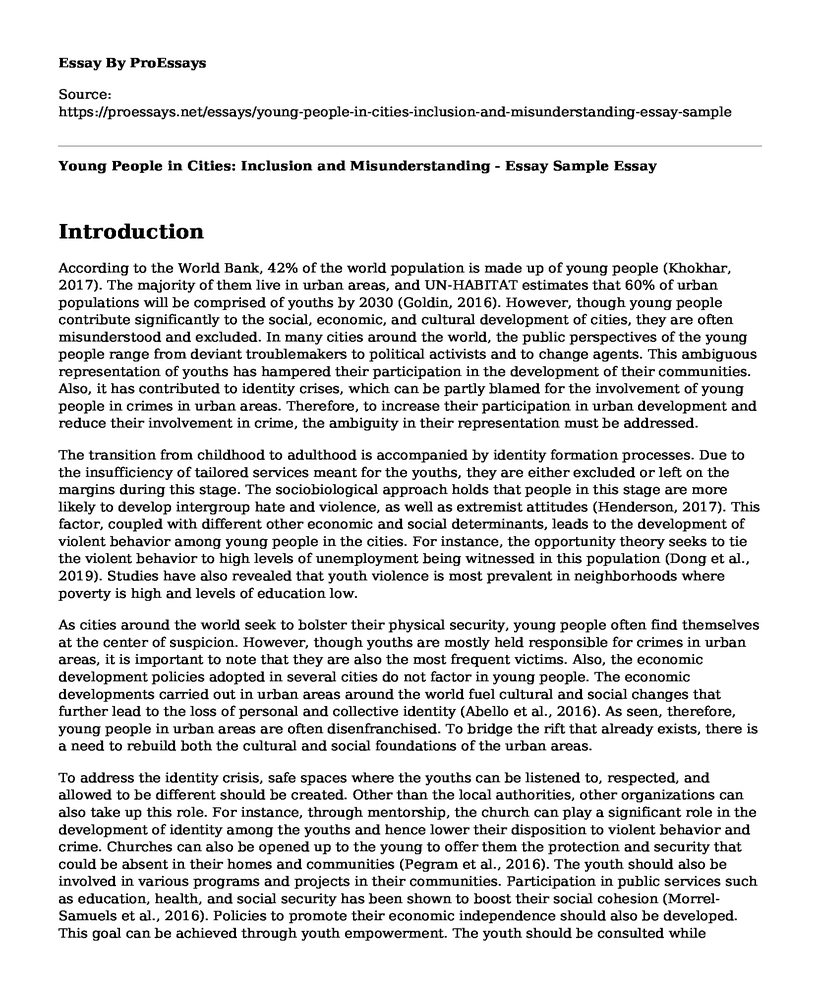Introduction
According to the World Bank, 42% of the world population is made up of young people (Khokhar, 2017). The majority of them live in urban areas, and UN-HABITAT estimates that 60% of urban populations will be comprised of youths by 2030 (Goldin, 2016). However, though young people contribute significantly to the social, economic, and cultural development of cities, they are often misunderstood and excluded. In many cities around the world, the public perspectives of the young people range from deviant troublemakers to political activists and to change agents. This ambiguous representation of youths has hampered their participation in the development of their communities. Also, it has contributed to identity crises, which can be partly blamed for the involvement of young people in crimes in urban areas. Therefore, to increase their participation in urban development and reduce their involvement in crime, the ambiguity in their representation must be addressed.
The transition from childhood to adulthood is accompanied by identity formation processes. Due to the insufficiency of tailored services meant for the youths, they are either excluded or left on the margins during this stage. The sociobiological approach holds that people in this stage are more likely to develop intergroup hate and violence, as well as extremist attitudes (Henderson, 2017). This factor, coupled with different other economic and social determinants, leads to the development of violent behavior among young people in the cities. For instance, the opportunity theory seeks to tie the violent behavior to high levels of unemployment being witnessed in this population (Dong et al., 2019). Studies have also revealed that youth violence is most prevalent in neighborhoods where poverty is high and levels of education low.
As cities around the world seek to bolster their physical security, young people often find themselves at the center of suspicion. However, though youths are mostly held responsible for crimes in urban areas, it is important to note that they are also the most frequent victims. Also, the economic development policies adopted in several cities do not factor in young people. The economic developments carried out in urban areas around the world fuel cultural and social changes that further lead to the loss of personal and collective identity (Abello et al., 2016). As seen, therefore, young people in urban areas are often disenfranchised. To bridge the rift that already exists, there is a need to rebuild both the cultural and social foundations of the urban areas.
To address the identity crisis, safe spaces where the youths can be listened to, respected, and allowed to be different should be created. Other than the local authorities, other organizations can also take up this role. For instance, through mentorship, the church can play a significant role in the development of identity among the youths and hence lower their disposition to violent behavior and crime. Churches can also be opened up to the young to offer them the protection and security that could be absent in their homes and communities (Pegram et al., 2016). The youth should also be involved in various programs and projects in their communities. Participation in public services such as education, health, and social security has been shown to boost their social cohesion (Morrel-Samuels et al., 2016). Policies to promote their economic independence should also be developed. This goal can be achieved through youth empowerment. The youth should be consulted while making various decisions to help develop genuinely youth-centered strategies. It is a potent tool for creating social cohesion.
References
Abello, A., Cassells, R., Daly, A., D'Souza, G., & Miranti, R. (2016). Youth social exclusion in Australian communities: A new index. Social Indicators Research, 128(2), 635-660. Retrieved from https://link.springer.com/article/10.1007/s11205-015-1048-9
Dong, B., Morrison, C. N., Branas, C. C., Richmond, T. S., & Wiebe, D. J. (2019). As Violence Unfolds: A Space-Time Study of Situational Triggers of Violent Victimization Among Urban Youth. Journal of Quantitative Criminology, 1-34. Retrieved from https://link.springer.com/article/10.1007/s10940-019-09419-8
Goldin, N. (2016, October 20). A tale of twin demographics: Youth in cities. Retrieved from World Bank: https://blogs.worldbank.org/jobs/tale-twin-demographics-youth-cities
Henderson, B. B. (2017). Psychological Theories of Crime. The Encyclopedia of Juvenile Delinquency and Justice, 1-6. Retrieved from https://onlinelibrary.wiley.com/doi/abs/10.1002/9781118524275.ejdj0177
Khokhar, T. (2017, April 17). Chart: How is the world's youth population changing? Retrieved from World Bank: https://blogs.worldbank.org/opendata/chart-how-worlds-youth-population-changing
Morrel-Samuels, S., Baccalao, M., Brown, S., Bower, M., & Zimmerman, M. (2016). Community engagement in youth violence prevention: Crafting methods to context. The journal of primary prevention, 37(2), 189-207. Retrieved from https://link.springer.com/article/10.1007/s10935-016-0428-5
Pegram, K., Brunson, R. K., & Braga, A. A. (2016). The doors of the church are now open: Black clergy, collective efficacy, and neighborhood violence. City & Community, 15(3), 289-314. Retrieved from https://onlinelibrary.wiley.com/doi/abs/10.1111/cico.12191
Cite this page
Young People in Cities: Inclusion and Misunderstanding - Essay Sample. (2023, Jun 22). Retrieved from https://proessays.net/essays/young-people-in-cities-inclusion-and-misunderstanding-essay-sample
If you are the original author of this essay and no longer wish to have it published on the ProEssays website, please click below to request its removal:
- Covenant Unions: Justice, Gender and Family Essay
- Research Paper on How Society Has Influenced the Growth and Complexity of the Coca-Cola Company
- Essay Sample on Developmental Psychology: Parenting Related to Development of Children
- Article Analysis Essay on "Social and Emotional Development in Children"
- Essay Example on Social Media: Positive & Negative Impacts on Society
- Essay on Living in My Community: 231 S Jasper Circle Unit 101, Aurora, CO
- Essay Example on Parents: Get the Best Value with Interchangeable Child Carriage (ICC)!







